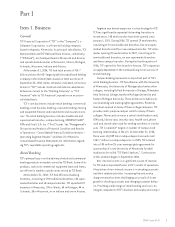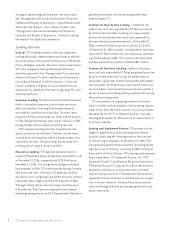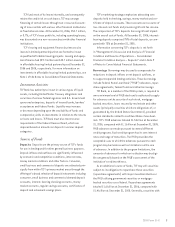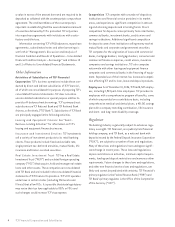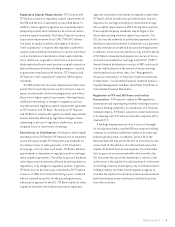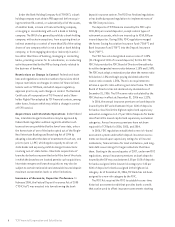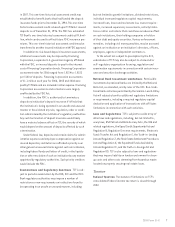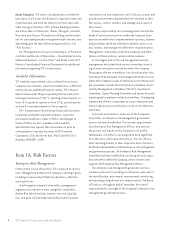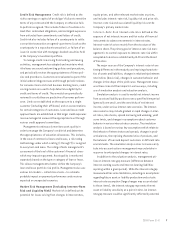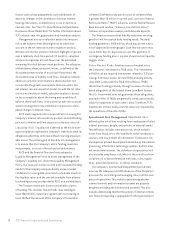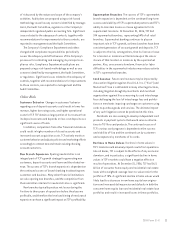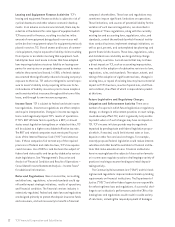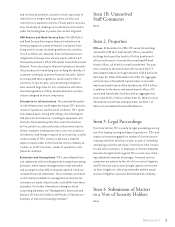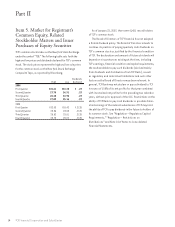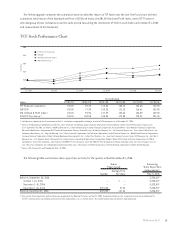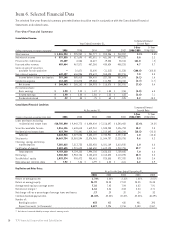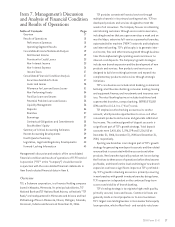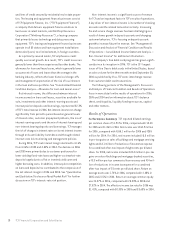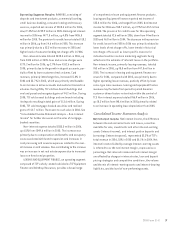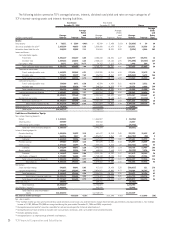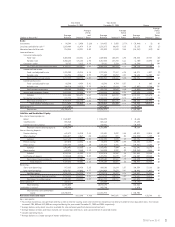TCF Bank 2006 Annual Report Download - page 31
Download and view the complete annual report
Please find page 31 of the 2006 TCF Bank annual report below. You can navigate through the pages in the report by either clicking on the pages listed below, or by using the keyword search tool below to find specific information within the annual report.
2006 Form10-K 11
of risks posed by the nature and scope of the company’s
activities. Audit plans are prepared using a risk-based
methodology as well as any concerns identified by manage-
ment, the Audit Committee, regulators or the Company’s
independent registered public accounting firm. Significant
issues related to the adequacy of controls, together with
recommendations for improvements to those controls, are
reported to management and the Audit Committee.
The Company’s Compliance Department and others
charged with compliance responsibilities periodically
assess the adequacy and effectiveness of the Company’s
processes for controlling and managing its principal com-
pliance risks. Compliance Department audit plans are
prepared using a risk-based methodology as well as any
concerns identified by management, the Audit Committee,
or regulators. Significant issues related to the adequacy of
controls, together with recommendations for improvements
to those controls, are reported to management and the
Audit Committee.
Other Risks
Customer Behavior Changes in customers’ behavior
regarding use of deposit accounts could result in lower fee
revenue, higher borrowing costs, and higher operational
costs for TCF. TCF obtains a large portion of its revenue from
its deposit accounts and depends on low-cost deposits as a
significant source of funds.
In addition, competition from other financial institutions
could result in higher numbers of closed accounts and
increased account acquisition costs. TCF actively monitors
customer behavior and adjusts policies and marketing efforts
accordingly to attract new and retain existing checking
account customers.
New Branch Expansion Opening new branches is an
integral part of TCF’s growth strategy for generating new
customers, deposit accounts and loans and the related rev-
enue. The success of TCF’s branch expansion is dependent on
the continued success of branch banking in attracting new
customers and business. Many other financial institutions
are also opening new branches, and the competition from
them and other retailers for new branch sites is significant.
New branches typically produce net losses during the
first two to three years of operations before they become
profitable, and therefore the level and timing of new branch
expansion can have a significant impact on TCF’s profitability.
Supermarket Branches The success of TCF’s supermarket
branch expansion is dependent on the continued long-term
success and viability of TCF’s supermarket partners and TCF’s
ability to maintain licenses or lease agreements for its
supermarket locations. At December 31, 2006, TCF had
244 supermarket branches, representing 54% of all retail
branches. Supermarket banking continues to play an
important role in TCF’s growth, as these branches have been
consistent generators of account growth and deposits. TCF
is subject to the risk, among others, that its license or lease
for a location or locations will terminate upon the sale or
closure of that location or locations by the supermarket
partner. Also, an economic slowdown, financial or labor
difficulties in the supermarket industry may reduce activity
in TCF’s supermarket branches.
Card Revenue Future card revenues may be impacted by
class action litigation against Visa U.S.A. Inc. (“Visa”) and
MasterCard®
. Visa is a defendant in many other legal actions,
including litigation brought by merchants and merchant
organizations against Visa concerning its card interchange
fees challenging the level of interchange fees and prohibi-
tions on merchants imposing surcharges on customers using
cards to purchase goods and services. The ultimate impact
of any such litigation cannot be predicted at this time.
Merchants are also seeking to develop independent card
products or payment systems that would serve as alterna-
tives to TCF Visa card products. The continued success of
TCF’s various card programs is dependent on the success
and viability of Visa and the continued use by customers
and acceptance by merchants of its cards.
Declines in Home Values Declines in home values in
TCF’s markets could adversely impact results from operations.
Like all banks, TCF is subject to the effects of any economic
downturn, and in particular, a significant decline in home
values in TCF’s markets could have a negative effect on
results of operations. At December 31, 2006, TCF had $6.5
billion of consumer home equity and residential real estate
loans with a weighted-average loan-to-value ratio for the
portfolio of 78%. A significant decline in home values would
likely lead to a decrease in new home equity loan origina-
tions and increased delinquencies and defaults in both the
consumer home equity loan and residential real estate loan
portfolios and result in increased losses in these portfolios.


